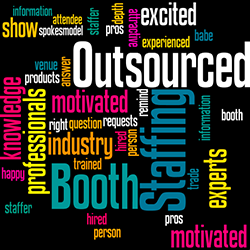 |
 Bob Milam, independent industry consultant, is a former EXHIBITOR Editorial Advisory Board member and a past All-Star Award winner, and a current EXHIBITOR Conference advisory board and faculty member. tradeshowbob@gmail.com Bob Milam, independent industry consultant, is a former EXHIBITOR Editorial Advisory Board member and a past All-Star Award winner, and a current EXHIBITOR Conference advisory board and faculty member. tradeshowbob@gmail.com
|
| |
 ave you ever looked back at your old yearbook from high school? In mine, someone named Dave wrote, "Remember that night at the cabin, and always stay squishy, dude!" And some girl added, "Stay a sweetie! Always! And keep your feet warm!" Reading those comments, I wonder what about me was squishy in high school. That was when I was in good shape! And why were my feet cold? ave you ever looked back at your old yearbook from high school? In mine, someone named Dave wrote, "Remember that night at the cabin, and always stay squishy, dude!" And some girl added, "Stay a sweetie! Always! And keep your feet warm!" Reading those comments, I wonder what about me was squishy in high school. That was when I was in good shape! And why were my feet cold?
Those indecipherable yearbook quotes are a lot like the leads I took home one year from the Institute of Food Technologists show. In both cases I was reading notes written by people who were trying to tell me something, but the messages on the paper left me scratching my head.
At IFT, I conducted a little experiment on behalf of my employer at the time, Kerry Group Inc. To see how well the company followed up on what its staffers promised in the booth, I hired a couple of college kids to survey attendees. Every time one of the students saw a booth staffer have a conversation with an ttendee, the student approached the visitor with an exit survey to
determine what he or she expected from my company after the show.
Based on the surveys, 750 attendees left our exhibit expecting follow-up communication. But when we got home and counted our leads, only 150 forms noted any need to follow up.
After some more analysis, I determined that much of the discrepancy was attributed to bad lead taking. No one had determined what information made a lead form actionable. Furthermore, the staff wasn't trained on how to get good info from attendees and effectively record it for post-show follow-up. Long conversations with
attendees typically produced little more than lead forms with some contact info and a note saying, "So and so stopped by to say hi." No request for follow-up was noted, but those attendees left the show expecting phone calls.
To combat this problem, I designed
a better lead form, one that matched the needs of my sales team, and trained our booth staff on how to complete it. As a result, we were able to haul in more actionable leads the following year. Even better, our sales staff didn't gripe about getting a pile of useless forms, and all attendees who expected phone calls and follow-up got exactly what they requested.
If you are having problems with leads that don't provide actionable information, follow these three steps to turn those incoherent slips of paper into valuable sales tools.
 Get Buy-in Get Buy-in
First, determine who will be responsible for following up on the leads you collect at the trade show. Usually, this will be your company's sales team. So sit down with them and determine what kind of info your salespeople expect to glean from your lead forms. What information does each salesperson need in order to quickly decipher the data, categorize the lead as hot or cold, and follow up accordingly?
You will likely find that actionable information includes which products or services the prospect showed interest in, whether that prospect plans to make a purchase within a particular time frame, the volume of product he or she needs, and what kind of budget his or her company has to spend. By knowing what information your sales team needs to follow up with a lead, you'll have a clear idea of how the lead form should be designed and what information your booth staff needs to note on the form.
 Design The Form Design The Form
Depending on who is responsible for lead follow-up,
which market segment you're targeting, and what information your sales team requires from the attendees to take post-show action, your lead form might change from show to show. Just make sure this form contains
the questions and answers that will make your internal stakeholders happy. That said, there are three basic categories of information every good lead should have.
 The Facts: At the very least, you want to get a person's name and his or her contact information such as a phone number, e-mail address, and
a company name and job title. An even better lead might contain a
second point of contact with the
company who is also responsible
for specifying, recommending, or influencing purchasing decisions. The Facts: At the very least, you want to get a person's name and his or her contact information such as a phone number, e-mail address, and
a company name and job title. An even better lead might contain a
second point of contact with the
company who is also responsible
for specifying, recommending, or influencing purchasing decisions.
While much of this data probably comes from scanning an attendee's badge, don't trust that the scanner gave you everything you need. Verify the information, as people sometimes change jobs, move to new branch
offices, or get promotions between when they registered and when the show began. If need be, carefully hand write this info or get a current business card and staple it to the form.
 The Content: This is where to acquire the information requested by your internal stakeholders in step one. Basically, whatever information those stakeholders expect from an actionable lead is what you need to gather here. The key is to make sure you can collect
this data quickly and efficiently. A good form can be filled out during
or immediately following a basic conversation between your staffers and your booth visitors. For example, the form might include a list of products or services on display in the booth, so staffers can easily note the various makes and models attendees express interest in during the conversation. The Content: This is where to acquire the information requested by your internal stakeholders in step one. Basically, whatever information those stakeholders expect from an actionable lead is what you need to gather here. The key is to make sure you can collect
this data quickly and efficiently. A good form can be filled out during
or immediately following a basic conversation between your staffers and your booth visitors. For example, the form might include a list of products or services on display in the booth, so staffers can easily note the various makes and models attendees express interest in during the conversation.
 The Action: The last section of the form needs to include options on if, how, and when the attendee wants to be contacted after the show. Does the attendee want product-specific info
e-mailed within a week? Is the attendee expecting a phone call next month? If follow-up is not noted on the form, it's not likely to happen - and certainly not in the manner the attendee would prefer. So condition your staffers to complete this extremely important part of the lead form, or attendees
are likely to leave with follow-up
expectations that won't be met. The Action: The last section of the form needs to include options on if, how, and when the attendee wants to be contacted after the show. Does the attendee want product-specific info
e-mailed within a week? Is the attendee expecting a phone call next month? If follow-up is not noted on the form, it's not likely to happen - and certainly not in the manner the attendee would prefer. So condition your staffers to complete this extremely important part of the lead form, or attendees
are likely to leave with follow-up
expectations that won't be met.
 Train Your Team Train Your Team
Once your form is designed, work with your staffers to make sure they know what information an actionable lead form must contain. Show them examples of bad lead forms from the past, and conduct role-playing games to get them familiar with the kinds of questions they will need to ask in order to adequately complete the forms.
During the show, hold regular end-of-day meetings to review lead forms and note any consistent errors or omissions to help your team course correct as quickly as possible.
As it turns out, these steps helped solve my company's mystery of how 750 attendees who expected post-show
follow-up translated into only 150 actionable requests. Now, if I could just figure out what happened at the cabin in high
school.e
|




 Bob Milam, independent industry consultant, is a former EXHIBITOR Editorial Advisory Board member and a past All-Star Award winner, and a current EXHIBITOR Conference advisory board and faculty member.
Bob Milam, independent industry consultant, is a former EXHIBITOR Editorial Advisory Board member and a past All-Star Award winner, and a current EXHIBITOR Conference advisory board and faculty member.  Design The Form
Design The Form Train Your Team
Train Your Team


